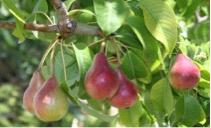Pear
-
Scientific NamePyrus communis
-
General InformationOf all deciduous fruit tree species, pears are the most tolerant of wet soil conditions. However, they are also the most pest-ridden of all fruit trees and require the most sprays to keep clean. The most common variety, 'Bartlett,' makes up 75% of the world's production.
 Photo: PlantMaster
Photo: PlantMaster -
When to Plant
Bare Root Although pear trees may be planted at any time of the year, they are most commonly purchased and planted during the winter months when they are dormant and available as bare root. If bare root trees cannot be planted soon after purchase, they should be temporarily “heeled in” by covering the roots with soil, sawdust, or compost, keeping the soil moist to prevent it from drying out.
-
Planting
Pear trees should be planted where they will receive full sun for six or more hours per day during the growing season. Site selection is important since pear trees can grow very large, requiring 18-foot spacing, without dwarfing rootstock or summer pruning. Before planting, examine the roots of bare root trees and cut off any roots that are broken or kinked. Container-grown trees may have circling or girdling roots, which should be gently pulled away from the root ball before the tree is planted.
Learn more about planting bare root trees.
-
Soil Requirements
Pear trees are the most tolerant of wet soil conditions. However, like all fruit trees, they grow best in deep (four feet or more), well-drained soil.
-
Water Requirements
Pear trees grow best if irrigated deeply once a month during the dry season. The amount and frequency of watering depends upon the size of the tree, soil type, and soil depth. Clay soils need less frequent irrigation, but require larger amounts of water to wet the soil deeply. Trees growing in shallow soils should be watered more often than those on deep soils.
-
Fertilizing
When first planting a bare root tree, just add top dressing compost. The second year, a healthy dose of compost around the base of the tree (away from the trunk) in the spring will meet the growing trees’ low nitrogen needs. Well established trees require moderate fertilization. For an organic fertilizer, apply five to seven pounds of rabbit or poultry manure. Each year continue to add compost around the base of the tree.
-
Pollination
Most pear varieties are self-sterile and require cross-pollination by another variety to get a good crop set. One exception is the 'Bartlett' pear which is a self-pollinating variety. If other varieties are selected for planting, plan to grow at least two varieties as they will need to be cross-pollinated. Also, make sure the varieties are compatible with each other.
-
Harvesting
Mature pear trees produce an abundance of fruit in a short window of time. Pears should be harvested when they are mature, but still hard. Do not allow pears to ripen on the tree. The harvest period for the 'Bartlett' pear is usually mid to late August.
-
Storage
To store pears, pick them when they are full size, but still very hard. Once harvested, keep the fruit in the refrigerator. Pears can also be stored in containers in a cool (about 40 degrees F) dark place for about a month or two.
-
Good Varieties for Marin
'Bartlett': The best quality pear. Fruits are bell-shaped, have white flesh, and excellent flavor. This variety is susceptible to fire blight.
'Bosc': Mid-season variety that bears heavy crops. Fruits are long necked and skin is golden rust brown.
'Comice': A non-consistent bearer of fruit. Excellent quality fruit, green in color with a red blush.
'D’Anjou': A good quality winter pear. Egg-shaped fruit, light green to yellow in color with white flesh.
‘Seckel’: Small but sweet. Excellent for home orchard. Resists fire blight and is self-fruitful.
-
Helpful Tips
Pruning: Learn how to prune pear trees.
Winter
- Spray trees with dormant oil to control San Jose scale, aphid eggs, mite eggs, and overwintering adult pear psylla.
- Prune 20% of last year’s growth to let light in.
- Remove diseased (fire blighted) and broken limbs.
Spring
- Spray trees with a fungicide to control pear scab at green tip stage, full bloom and at 10 day intervals until rain stops.
- Thin pears to 6 inches apart if crop is heavy.
- Fertilize prior to first irrigation.
- Apply 40 pounds of manure.
Summer
- Fertilize young trees monthly using half spring rates.
- Spray monthly (May 1 to August 1) to control codling moth worms. Time sprays to visual ID of worm holes in fruit.
- Control aphids if damage exceeds 50% of leaves crinkled and aphids present.
- Drip irrigate daily or sprinkler irrigate every two to three weeks.
Fall
- Using spring rates, fertilize and irrigate mature trees right after harvest.
- Clean up fallen fruit to reduce codling moth.
- At leaf fall, remove and destroy or compost leaves to prevent the spread of apple scab.
-
Common ProblemsN / A
-
Pests- Diseases & More
Fire blight (Erwinia amylovora) causes fire blight bacterial disease in pear trees. The bacteria overwinters in cracked, sunken cankers. During warm, wet, or humid weather, brown droplets ooze from infected cankers and move in splashing water and on insects to infect flowers and new shoots. Fire blight results in wilting, withering, and browning of shoots, blossoms, and fruit. Manage fire blight by growing resistant cultures, maintaining trees in an appropriate range of vigor, and quickly pruning off blighted growth. If fire blight remains a persistent problem, consider applying a copper bactericide (e.g. 0.5% Bordeaux mixture several times during bloom).
Pocket gophers can injure or kill a tree by feeding on the roots.
Learn more about growing pears.

